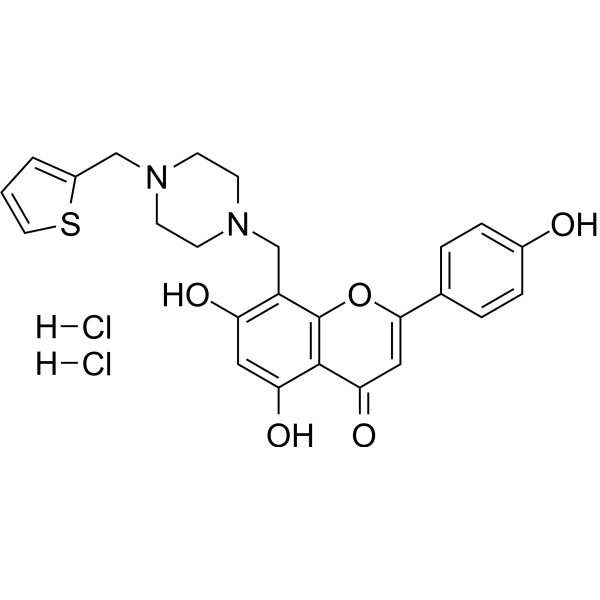Physicochemical Properties
| Molecular Formula | C25H26CL2N2O5S |
| Molecular Weight | 537.455343723297 |
| Exact Mass | 536.093 |
| CAS # | 2823308-89-8 |
| Related CAS # | PARP1-IN-5;2735645-53-9 |
| PubChem CID | 162370708 |
| Appearance | Light yellow to green yellow solid powder |
| Hydrogen Bond Donor Count | 5 |
| Hydrogen Bond Acceptor Count | 8 |
| Rotatable Bond Count | 5 |
| Heavy Atom Count | 35 |
| Complexity | 720 |
| Defined Atom Stereocenter Count | 0 |
| InChi Key | VIXDSXSUYRPYIN-UHFFFAOYSA-N |
| InChi Code | InChI=1S/C25H24N2O5S.2ClH/c28-17-5-3-16(4-6-17)23-13-22(31)24-21(30)12-20(29)19(25(24)32-23)15-27-9-7-26(8-10-27)14-18-2-1-11-33-18;;/h1-6,11-13,28-30H,7-10,14-15H2;2*1H |
| Chemical Name | 5,7-dihydroxy-2-(4-hydroxyphenyl)-8-[[4-(thiophen-2-ylmethyl)piperazin-1-yl]methyl]chromen-4-one;dihydrochloride |
| Synonyms | PARP1-IN-5 dihydrochloride |
| HS Tariff Code | 2934.99.9001 |
| Storage |
Powder-20°C 3 years 4°C 2 years In solvent -80°C 6 months -20°C 1 month Note: Please store this product in a sealed and protected environment, avoid exposure to moisture. |
| Shipping Condition | Room temperature (This product is stable at ambient temperature for a few days during ordinary shipping and time spent in Customs) |
Biological Activity
| Targets | PARP-1 ( IC50 = 14.7 nM ); PARP-2 ( IC50 = 0.9 μM ) |
| ln Vitro | In a dose-dependent manner, PARP1-IN-5 dihydrochloride (0.1~10 μM; A549 cells) can markedly increase the cytotoxicity of CBP on A549 cells. In SK-OV-3 cells, PARP1-IN-5 dihydrochloride (0.1–10 μM) reduces MCM2-7 expression. The cytotoxic effects of PARP1-IN-5 dihydrochloride (0.1~320 μM) on A549 cells are minimal. Dihydrochloride PARP1-IN-5 (SK-OV-3 cells) has the ability to dramatically lower the PAR level[1]. Via PARP-1, PARP1-IN-5 dihydrochloride has anticancer effects. Dihydrochloride of PARP1-IN-5 may raise the expression of γ-H2AX[1]. |
| ln Vivo | The results of PARP1-IN-5 dihydrochloride (1000 mg/kg; po) indicate that there is no statistically significant variation in blood routine or body weight[1]. The inhibitory impact of carboplatin on A549 cells at 50 mg/kg is greatly enhanced by PARP1-IN-5 dihydrochloride (25 and 50 mg/kg; po; 12 days)[1]. The expression of PARP-1 has a favorable correlation with PARP1-IN-5 dihydrochloride (50 mg/kg; po)[1]. Dihydrochloride PARP1-IN-5 has the ability to upregulate γ-H2AX expression while downregulating PAR expression[1]. |
| Animal Protocol |
Animal/Disease Models: Mice[1] Doses: 1000 mg/ kg Route of Administration: Po Experimental Results: There was no significant difference in the body weight and blood routine. Animal/Disease Models: Mice[1] Doses: 25 and 50 mg/kg Route of Administration: Po; 12 days Experimental Results: Dramatically enhanced the inhibitory effect of CBP on A549 cells at 50 mg/kg. Animal/Disease Models: Male Sprague−Dawley (SD) rats[1] Doses: 50 mg/kg (pharmacokinetic/PK Analysis) Route of Administration: Po Experimental Results: Positively correlated with the expression of PARP-1. |
| References |
[1]. Discovery of Novel Apigenin-Piperazine Hybrids as Potent and Selective Poly (ADP-Ribose) Polymerase-1 (PARP-1) Inhibitors for the Treatment of Cancer. J Med Chem. 2021;64(16):12089-12108. |
Solubility Data
| Solubility (In Vitro) |
DMSO : ~125 mg/mL (~232.6 mM) H2O : ~1 mg/mL (~1.9 mM) |
| Solubility (In Vivo) |
Solubility in Formulation 1: ≥ 2.08 mg/mL (3.87 mM) (saturation unknown) in 10% DMSO + 40% PEG300 + 5% Tween80 + 45% Saline (add these co-solvents sequentially from left to right, and one by one), clear solution. For example, if 1 mL of working solution is to be prepared, you can add 100 μL of 20.8 mg/mL clear DMSO stock solution to 400 μL PEG300 and mix evenly; then add 50 μL Tween-80 to the above solution and mix evenly; then add 450 μL normal saline to adjust the volume to 1 mL. Preparation of saline: Dissolve 0.9 g of sodium chloride in 100 mL ddH₂ O to obtain a clear solution. Solubility in Formulation 2: ≥ 2.08 mg/mL (3.87 mM) (saturation unknown) in 10% DMSO + 90% (20% SBE-β-CD in Saline) (add these co-solvents sequentially from left to right, and one by one), clear solution. For example, if 1 mL of working solution is to be prepared, you can add 100 μL of 20.8 mg/mL clear DMSO stock solution to 900 μL of 20% SBE-β-CD physiological saline solution and mix evenly. Preparation of 20% SBE-β-CD in Saline (4°C,1 week): Dissolve 2 g SBE-β-CD in 10 mL saline to obtain a clear solution. Solubility in Formulation 3: ≥ 2.08 mg/mL (3.87 mM) (saturation unknown) in 10% DMSO + 90% Corn Oil (add these co-solvents sequentially from left to right, and one by one), clear solution. For example, if 1 mL of working solution is to be prepared, you can add 100 μL of 20.8 mg/mL clear DMSO stock solution to 900 μL of corn oil and mix evenly. (Please use freshly prepared in vivo formulations for optimal results.) |
| Preparing Stock Solutions | 1 mg | 5 mg | 10 mg | |
| 1 mM | 1.8606 mL | 9.3030 mL | 18.6060 mL | |
| 5 mM | 0.3721 mL | 1.8606 mL | 3.7212 mL | |
| 10 mM | 0.1861 mL | 0.9303 mL | 1.8606 mL |
